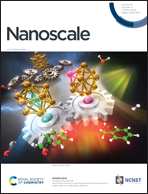Reversible optical control of magnetism in engineered artificial multiferroics†
Abstract
Optical means instead of electric fields may offer a new pathway for low-power and wireless control of magnetism, holding great potential to design next-generation memory and spintronic devices. Artificial multiferroic materials have shown remarkable suitability as platforms towards the optical control of magnetic properties. However, the practical use of magnetic modulation should be both stable and reversible and, particularly, it should occur at room temperature. Here we show an unprecedented reversible modulation of magnetism using low-intensity visible-light in Fe75Al25/BaTiO3 heterostructures, at room temperature. This is enabled by the existence of highly oriented charged domain walls arranged in arrays of alternating in-plane and out-of-plane ferroelectric domains with stripe morphology. Light actuation yields a net anisotropic stress caused by ferroelectric domain switching, which leads to a 90-degree reorientation of the magnetic easy axis. Significant changes in the coercivity and squareness ratio of the hysteresis loops can be light-modulated, encouraging the development of novel low energy-consumption wireless magneto-optical devices.



 Please wait while we load your content...
Please wait while we load your content...